1996 PONTIAC BONNEVILLE instrument panel
[x] Cancel search: instrument panelPage 143 of 387
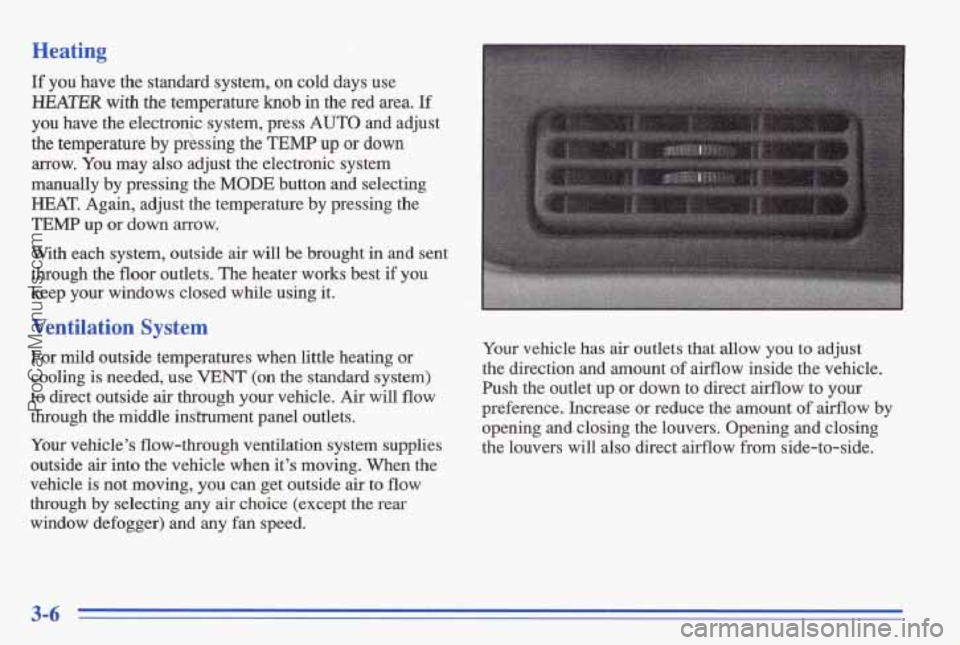
Heating
If you have the standard system, on cold days use
HEATER with the temperature knob in the red area. If
you have the electronic system, press AUTO and adjust
the temperature by
p;essing the TEMP up or down
arrow. You may also adjust the electronic system
manually by pressing the
MODE button and selecting
HEAT. Again, adjust the temperature by pressing the
"EMF up or down arrow.
With each system, outside air
will be brought in and sent
through the
floor outlets. The heater works best if you
keep your windows closed while using it.
Ventilation System
For mild outside temperatures when littkheating or
cooling is needed, use
VENT (on the standard system)
to direct outside air through your vehicle. Air will flow
through the middle instrument panel outlets.
Your vehicle's flow-through ventilation system supplies
outside
air into the vehicle when it's moving. When the
vehicle
is not moving, you can get outside air to flow
through
by selecting any air choice (except the rear
,window defogger) and any fan speed. Your
vehicle has air outlets that allow
you to adjust
the direction and amount
of airflow inside the vehicle.
Push the outlet up or down to direct airflow to your
preference. Increase or reduce the amount of airflow by
opening and closing the louvers. Opening and closing
the louvers will
also direct airflow from side-to-side.
ProCarManuals.com
Page 204 of 387

Making Turns
NOTICE:
Making very sharp turns while trailering could
cause the trailer to come in contact with the
vehicle. Your vehicle could be damaged. Avoid
making very sharp turns while trailering.
When you’re turning with a trailer, make wider turns than
normal. Do this so your trailer won’t strike soft shoulders,
curbs, road signs, trees or other objects. Avoid jerky
or
sudden maneuvers. Signal well in advance. ‘
. Turn ,Signals When Towing a Trailer’
When you tow a trailer, your vehicle may need a
different
turn signal flasher and/or extra wiring. Check
with your Pontiac dealer. The green
arrows on your
instrument panel will flash whenever you signal a turn
or lane change. Properly hooked up,’ the trailer lamps
will also flash, telling other drivers you’re about to turn,
change lanes or stop. When towing a trailer, the green arrows
on your
instrument panel will flash for turns
even if the bulbs on
the trailer are burned out.
Thus, you may think drivers
behind you are seeing your signal when they are not. It’s
important to check occasionally to be sure the trailer
bulbs are still working.
Your vehicle has bulb warning lights. When you’plug
a trailer lighting system into your vehicle’s lighting
system, its bulb warning lights may not let you
know if
one of your lamps goes out. So, when you have a trailer
lighting system plugged in, be sure to check your
vehicle and trailer lamps
from time to time to be sure
they’re
all working. Once you disconnect the trailer
lamps, the bulb warning lights again can tell you
if one
of ypur vehicle lamps is out.
Driving On Grades
Reduce speed and shift to a lower gear before you start
down a long or steep downgrade.
If you don’t shift
down, you might have to use your brakes so much that
they. would get hot
and no longer work well.
On a long uphill grade, shift down to Dm (D) and
reduce your speed to around
45 mph (70 km/h) to reduce
the possibility of engine and transaxle overheating.
4-37
ProCarManuals.com
Page 220 of 387
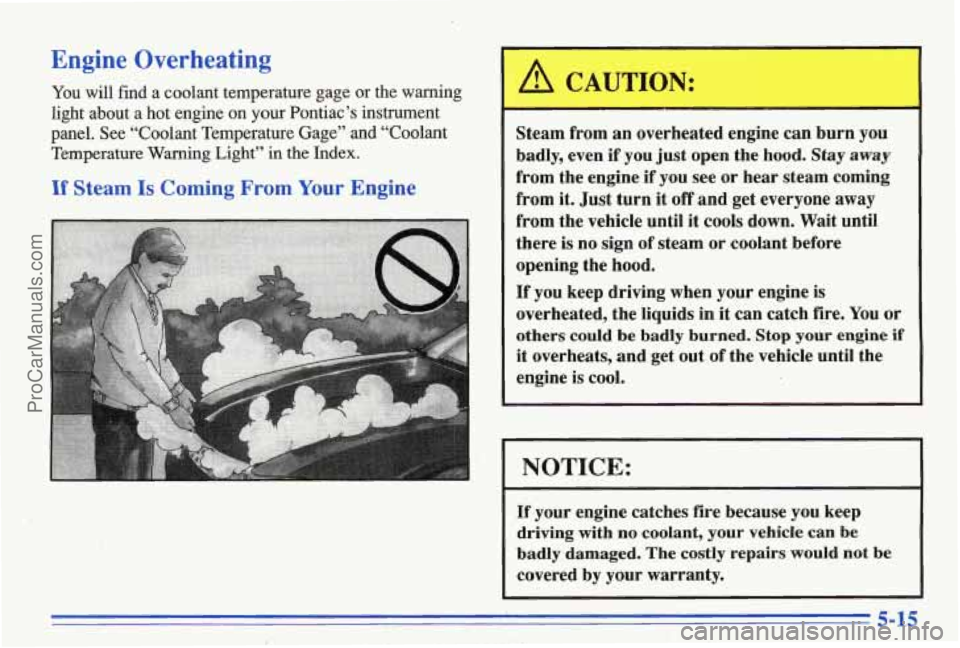
Engine Overheating
You will find a coolant temperature gage or the warning
light about a hot engine
on your Pontiac’s instrument
panel. See “Coolant Temperature Gage” and “Coolant Temperature Warning Light” in the Index.
If Steam Is Coming From Your Engine
I
Steam from an overheated engine can burn you
badly, even if you just open the hood. Stay
away
from the engine if you see or hear steam coming
from it. Just turn it
off and get everyone away
from the vehicle until it cools down. Wait until
there is no sign of steam or coolant before
opening the
hood.
If you keep driving when your engine is
overheated, the liquids in it can catch fire. You
or
others could be badly burned. Stop your engine if
it overheats, and get out of the vehicle until the
engine is cool.
I
NOTICE:
If your engine catches fire because you keep
driving with no coolant, your vehicle can be
badly damaged. The costly repairs would not be
covered
by your warranty.
5-15
ProCarManuals.com
Page 247 of 387
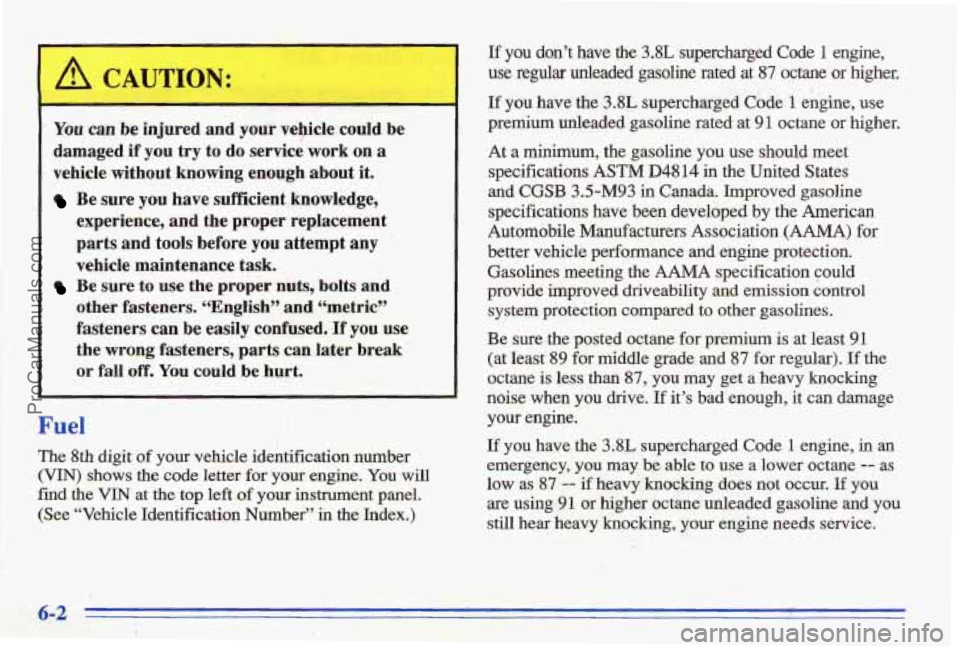
You can be injured and your vepicle could be
damaged
if‘ you try to do service work on a
vehicle without knowing enough about it.
Be sure you have sufficient .knowledge,
experience,
and the proper replacement
parts and tools before you attempt any
vehicle maintenance task.
Be sare to use the proper nuts, bolts and
other fasteners. %nglishs’ and “metric”
fasteners can be easily confhsed.
If you use
the wrong fasteners, parts can later break ‘
or fall off. You could be hurt. ,.
Fuel .. b ’ .’. ‘ _. . .. ,. --
-The 8th digit of your vehicle identification number .. I
(VIN) shows the code letter for your engine. You ,will
find the VIN at the top left of your instrument panel.
(See “Vehicle Identification Number”
m the Index.)
’Y i,
If you don’t have the 3.8L supercharged Code 1 engine,
use regular unleaded gasoline rated at 87 octane or higher.
If you have the 3.8L supercharged, Code 1 ehgine, use
premium unleaded gasoline rated at 9 1 octane or higher.
At a
minimum, the gasoline you use should meet
specifications
ASTM I34814 in the United States
and CGSB 3.5-M93 in Can& Improved gasoline
specifications have been developed by the American
Automobile Manufacturers Association
(AAMA) for
better vehicle performance and ehgine protection.
Gasolims meeting the AAMA specification could
provide
improved driveability and emission control
system protkction compared to other gasolines.
Be sure
the posted octane for premium is at least 91
(at least 89 for middle grade and 87 for regular), I€ the
octane is
less than 87, you may get a heavy knocking
noise when you drive. If it’s bad-enough, it can damage
your engine.
. If you have the 3.8L supercharged Code 1 engine, in an
emergency, you may be able to use a lower octane -- as
low as 87 -- if heavy knocking does not occur. If you
are using 91 or higher octane unleaded gasoline and you
still hear heavy knocking, YQW engine needs service.
/
ProCarManuals.com
Page 248 of 387
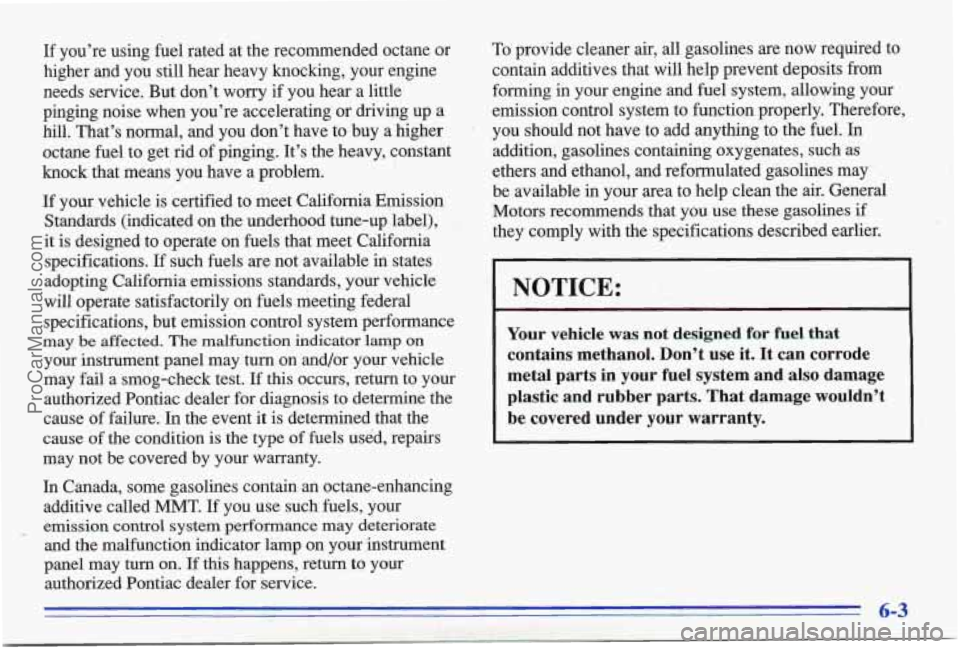
If you’re using fuel rated at the recommended octane or
higher and you stiil hear heavy knocking, your engine
needs service. But don’t worry
if you hear a little
pinging noise when you’re accelerating or driving up
a
hill. That’s normal, and you don’t have to buy a higher \
octane fuel to get rid of pinging. It’s the heavy, constant
knock that means you have a problem.
If your vehicle is certified to meet California Emission
Standards (indicated on the underhood tune-up ’label),
it is designed to operate on fuels that meet California
specifications.
If such fuels are not available in states
adopting California emissions standards, your vehicle
will operate satisfactorily on fuels meeting federal
specifications, but emission control system performance
may be eected. The malfunction indicator lamp on
your instrument panel may turn on and/or-your vehicle may fail a smog-check test.
If this occurs, return to your
authorized Pontiac dealer for diagnosis to determine the
cause of failure.
In the event it is determined that the
cause
of the condition is the type of fuels used, repairs
may not be covered by your warranty.
In Canada, some gasolines contain an octane-enhancing
additive called MMT.
If you use such fuels, your
, emission control system performance may deteriorate
and the malfunction indicator lamp on your instrument
panel may turn on.
If this happens, return to your
authorized Pontiac dealer for service.
To provide cleaner air, all gasolines are now required to
contain additives that will help prevent deposits from
forming in your engine and fuel system, allowing your
emission control system to function properly. Therefore,
you should not have to add anything
to the fuel. In
addition, gasolines containing oxygenates, such as
ethers and ethanol, and reformulated gasolines may
be available in your area to help clean the air. General
Motors recommends that you use these gasolines
if
they mcomply with the specifications described earlier.
NOTICE:
Your vehicle was not designed for fuel that
contains methanol. Don’t use it. It can corrode
metal parts in your fuel system and also damage
plastic and rubber parts. That damage
wouldn’t
be covered under your warranty.
ProCarManuals.com
Page 257 of 387
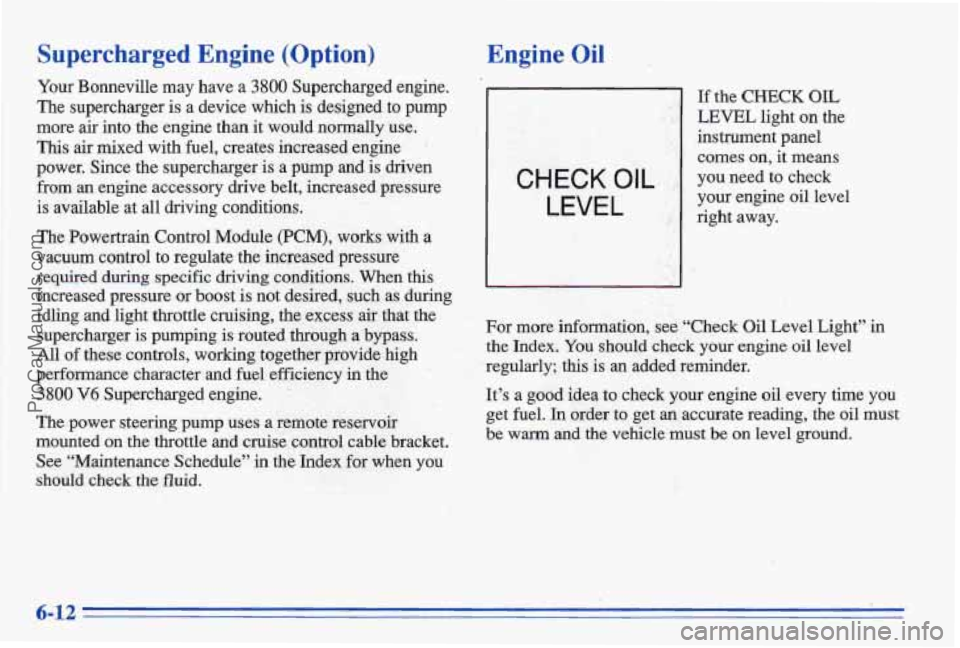
Supercharged Engine (Option)
Your Bonneville may have a 3800 Supercharged engine.
The supercharger is a device which is designed
to pump
more
air into the engine than it would normally use.
This air mixed with fuel, creates increased engine
power. Since the supercharger is a pump
and is driven
from an engine accessory drive belt, increased pressure
is available at all driving conditions.
The Powertrain Control Module (PCM), works with a
vacuum control to regulate the increased pressure
required
during specific driving conditions. When this
increased pressure or boost is not desired, such as during
idling
and light throttle cruising, the excess air that the
supercharger is pumping is routed through
a bypass.
All of these controls, working together provide high
performance character
and fuel efficiency in the
38010 V6 Supercharged engine.
The-power steering pump uses a remote reservoir
mounted on the throttle and cruise control cable bracket.
See “Maintenance Schedule”
in the Index for when you
should check the fluid.
I ’. .. ,- .. .. , . -. :? 1
Engine Oil
CHECK OIL
LEVEL
If the CHECK OIL
LEVEL light on the
instrument panel comes
on, it means
you need to check
your engine oil level
right away.
For more information, see “Check Oil Level Light”
in
the Index. You should check your engine oil level
regularly; this is
an added reminder.
It’s a good idea
to check your engine oil every time you
get fuel. In order to get an accurate reading, the oil must
be warm and the vehicle must be on level ground.
6-12
ProCarManuals.com
Page 297 of 387
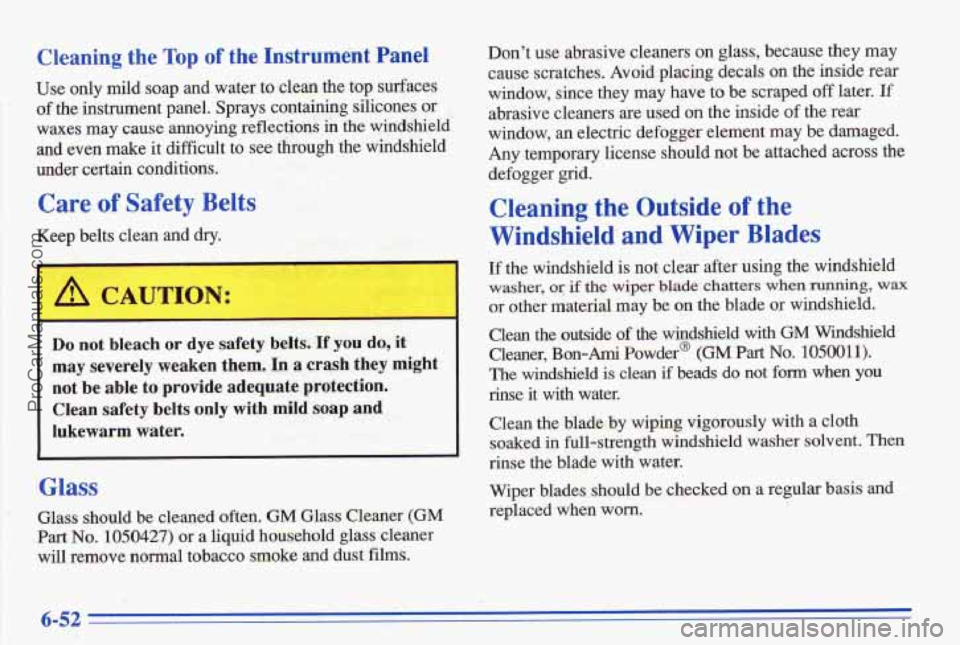
Cleaning the Top of the Instrument Panel
Use only mild soap and water to clean the top surfaces
of the instrument panel. Sprays containing silicones or
waxes may cause annoying reflections
in the windshield
and even make it difficult to see through the windshield
under certain conditions.
Care of Safety Belts
Keep belts clean and dry.
---
I A CAUF 'N:
r
-
Do not bleach or dye safety belts. If you do, it
may severely weaken them. In a crash they might
not be able to provide adequate protection.
Clean safety belts
only with mild soap and
lukewarm water.
Glass
Glass should be cleaned often. GM Glass Cleaner (GM
Part No. 1050427) or a liquid household glass cleaner
will remove norha1 tobacco smoke and dust films.
Don't use abrasive cleaners on glass, because they may
cause scratches. Avoid placing decals
on the inside rear
window, since they may have to be scraped
off later. Ilf
abrasive cleaners are used on the inside of the rear
window, an electric defogger element may be damaged.
Any temporary license should not be attached across the
defogger grid.
Cleaning the Outside of the
Windshield' and Wiper Blades
Lf the windshield is not clear after using the windshield
washer, or if the wiper blade chatters when Npning, wax
or other material m'ay be on the blade or windshield.
Clean the outside
of the wirmdshield with GM Windshield
Cleaner, Bon-Ami Powder@
(GM Part No. lQS0011).
The windshield is clean if beads do not form when you
rinse it with water.
Clean the blade by wiping vigorously with a cloth
soaked
in full-strength windshield washer solvent. Then
rinse the
blade with water.
Wiper blades should be checked
on a regular basis and
replaced when
worn.
6-52
.
ProCarManuals.com
Page 301 of 387

Appearance Care Materials Chart
12345725 I 12 oz. (0.354 L) I Silicone Tire Shine I Shines tires
I See your General Mators Parts Department for these products. * Not recornmended for pigskin suede leather.
See “Fluids and Lubric’ants” in the Index. **Not recommended for use on instrument panel vinyl.
6-56
ProCarManuals.com